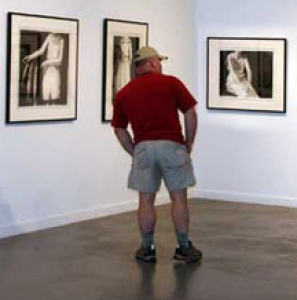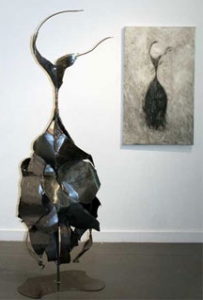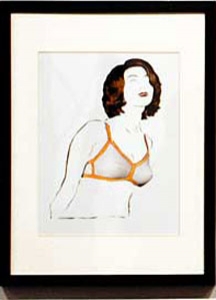Past Exhibition
(EX)POSE
Judy Daley
Debbie Schenk
Sabine Maier
September 2007
Our fall show presents three different viewpoints on gendered identity, body language and cultural memory through the works of Judy Daley (Acton), Debbie Schenk (Walkerton) and Sabine Maier (Vienna). Drawing from the world of archival family shots, pin-up culture and the timeless fashion of the little black dress, the works in this show share a contemporary exploration of both body politics and culturally accepted images of femininity.
Working from photographic enlargements of salvaged nitrate negatives from the 30s to the 50s Judy Daley developed a series of drawings - fragments of the original images that isolate and de-personalize their subjects in order to restore a lost narrative that encompasses both fact and fiction.
With soft pencil strokes Daley re-creates lucid compositions of young girls and women in front of dark shaded backgrounds spotlighting the act of posing for a camera. Gestures and body language range from passivity to strength and artlessness to complicity. Feminine traits and attributes are also being communicated through the outfits these women are wearing. Simplicity and inconspicuousness are some of the characteristics of the underlying dress code in these drawings, projecting a womanly image that is gentle, good-natured, decent, romantic and unspoiled. Sexuality seems to play only a subordinate role. In contrast there is also the active buddy-type persona wearing loose trousers that reference masculinity and project a womanly image characterized by independence, efficiency, control and confidence.
Power and sophistication are some of the female attributes inscribed in Debbie Schenk’s semi-abstract black and white oil paintings of cocktail dresses. The sculptural forms of the painted dresses project female body shapes from the skinny to the voluptuous. In her visual interplay between image and words, black and white and its connotations, Schenk addresses the ambivalence of a good/bad woman, the exciting conflict between desire and fear. The white dress connotates the allusion of weakness, purity, innocence and beauty in light, underscoring the mood of bittersweet sensuality. Keep in mind, even a woman dressed in white can be fatal. The black dress, a cultural icon since the 1920’s, expresses emotions and drama and echoes mystery, danger, evil, superiority and attraction.
Subverting stereotypical images of women reveling in their own sex appeal, Sabine Maier created a series of hand processed and sometimes colourized photographs of women friends who posed as super sexy bombshells and pin-ups in 40s and 50s lingerie. Existing in a space between pornography and portraiture, from its origins the pin-up presented women with a template for representing one’s sexuality implicitly as opposed to explicitly--with all the play, guises and control that accompanies this kind of highly posed portrayal. Pin-up is not always a form of manipulation of women, rather, it can be a source of empowerment, allowing women to present themselves as powerful and in control. Maier’s Pins series provides an insight into the many ways that women have defined, politicized and represented their own sexuality in the public eye.
Reconciling identity through artistic practice, the works in this show serve as an investigation of the tension between the concepts of self, body, and identity.
- Ilse Gassinger



